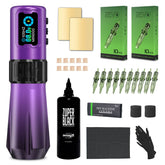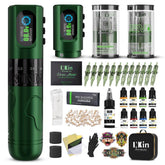Best Practices for Tattoo Machine and Hygiene
People who are new to the tattoo industry may have questions like ‘should I wrap my pen?’ or ‘if I wrapped my machine, should I still need to autoclave it?’. Well, when things relate to health, always do your best.
Proper hygiene isn’t just about wiping down the surface of your tools. It’s about responsibility. Protecting your equipment and autoclaving it is to ensure client safety, maintain precision in your work, to give the ideal result to your clients.
In this article, we are going to talk about:
- Should your tattoo guns be wrapped or not.
- What used to wrap your pen.
- How to clean a tattoo machine.
Why Cleaning Alone isn’t Enough
Some people may think a thorough wipe-down after each appointment does the trick, but here is the reality: Cleaning alone the surface may get rid of the visible stains, but it cannot prevent hidden cross-contamination, nor can it protect power supplies from ink or ointment penetration.
1. Hidden Contamination
If you don’t cover your machine, ink, gel, and fluid products that you use during tattooing will have the chance to seep into the machine through seams around the grip, needle port, battery interface, cord connector, and charging port.
Once they succeed, even hospital-grade disinfectants cannot reach deep into places like that. And the damage is already done; there is no way to undo it.
Some tattoo guns are out of order, just several months later. Not being protected while using it might be a factor contributing to its breakdown.
If you have already been there, then, buy a new tattoo pen or apply a after-saleS service if it is still under its warranty. Some stores, like INKin Tattoo Supply, offer a 12-month warranty for motor and a 6-month warranty for battery.
2. Oil and Ointment Damage
Practicing on a piece of fake skin, vaseline is the must-have accessory. But are you aware that vaseline is a petroleum-based product? The primary ingredient of vaseline is petroleum jelly, also called petrolatum, a semi-solid mixture derived from petroleum refining. It is a byproduct of crude oil, but undergoes highly refined purification to remove impurities.
Petroleum jelly is non-conductive but can trap dust/debris, causing overheating or contact interference.
Imagine this: adjusting the operating voltage on a non-protected machine with your greasy hand and getting the ointment inside the battery. What might happen? Buttons may get stuck, and the battery is definitely ruined. And there is no way for you to clean it up inside.
3. Grip Stability Matters
Wireless tattoo pens mostly use aluminium as their material. Sweat, ink, vaseline, and gel residue would make the machine and grip slippery. How can we hold it steady then?
Wrapping it with elastic self-adhesive bandage to increase the friction. Especially in a long-session work, we need to make precise control and reduce hand fatigue. We cannot let this be a distraction from what we are doing.

4. Health Concerned
From the standpoint of clients, studios and artists should take their health into consideration for getting inked. Never heard a studio or an artist ask for health certification from their clients to prove they are clean, do not have HIV, or some other bacteria/viruses before tattooing. Given that, there is still a chance of infection, even if the probability is extremely low.
These are not fear-mongering, but practical advice for your client’s safety and your tattoo machines’ durability.
Anyone who has convinced themselves that they don’t need to wrap and clean their machine is like a surgeon who skips gloves.
What used to wrap your pen
In the case of pen-style tattoo machines, pros usually use disposable tattoo pen bags, elastic grip bandage wrap, and clip-cord sleeves (if you are using a cord when tattooing).
Disposable tattoo pen bags is able to fully enclose the machine body, block fluids. Basically, there is no need to use Saran Wrap, but it is never too much to use it. Make sure to choose the bag so that you can see the machine display clearly. You can also wrap the whole machine only with Saran Wrap in this step. Just to make sure the machine is fully wrapped.

Coil machines are more use barrier films, which is better than bags when it comes to wrapping irregular shapes. INKin sells disposable bags for coil machines.
Then use an elastic grip bandage to wrap the tattoo machine grip for a couple of rounds, in a bid to add traction. Be careful, don’t overwrap the grip, making it chonky.
Elastic grip bandage is self-adhesive, and breathable. It won’t leave any sticky marks that are hard to clean up. Another benefit of using an elastic bandage is to reduce vibration for better control and reduce hand fatigue.
Clip cord sleeves are used to prevent ink from sliding down cords and traveling to the power supply.
How to Clean a Tattoo Machine
After tattooing, remove and discard all the disposable wraps (never reuse). Spray the machine thoroughly with disinfectants like Cavicide, Barbicide, madacide, or similar and wipe, and let it dry naturally in a cool spot with good airflow before next-time bagging.
When you wipe it, channel more attention to the seams and connection points. Places like these are hard to clean up and easy to ignore.
Frequently Asked Questions
A: Yes—disposables keep the surface sanitary, but cleaning with antiviral/antibacterial wipes ensures any ink or fluids haven’t seeped inside. Combine both for full protection.
A: No. A few light passes of the wrap add grip and vibration dampening without bulk, and improve overall feel during prolonged sessions.
A: Absolutely not. They’re single‑use to avoid cross‑contamination. Dispose immediately after each appointment.
A: INKin Tattoo Supply sells tattoo machine bags for coil machines.
A: Yes! Its dual‑handle design and standard sizing are fully compatible with our tattoo pen bags, clip cord sleeves, and elastic grip wraps.
A: Use a bottle‑style machine bag with a transparent window or adjustable strip—this gives you full access. Adjust the voltage through the cover safely.










Leave a comment
All blog comments are checked prior to publishing